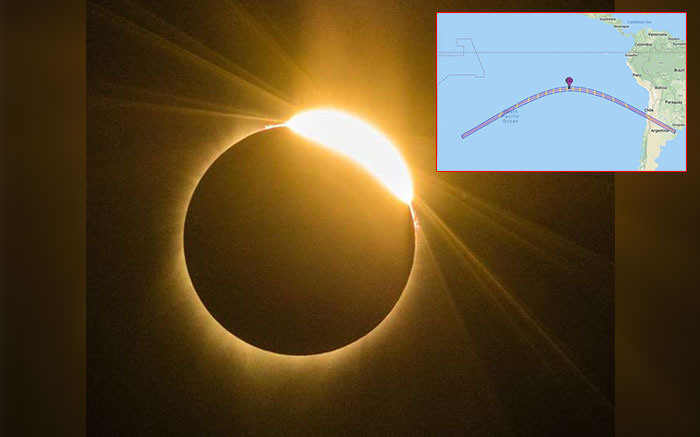- Sponsored -
Total Solar Eclipse 2019: Date, Time, Myths and Places To Observe From
Here are things you should know about the July 2, 2019 total solar eclipse. ... The upcoming eclipse will be the sole total solar eclipse to take place this year.

The Total Solar Eclipse is a natural phenomenon that takes place when the moon is in between the Earth and Sun and generates an Eclipse of the sun. On July 2, 2019 a Total Solar Eclipse will take place. It will be visible over Argentina and Chile in the Pacific and across South America. It will not be visible in India as it will take place at 10.25 pm IST. The upcoming eclipse will be four minutes and 33 seconds and will be the sole total solar eclipse to take place this year.
- Sponsored -
Here are few myths and facts about the celestial occurrence:
Total solar eclipse: Timing in India:
The partial eclipse will start at 12:55 pm EDT, which is 10:25 pm IST (Indian Standard Time). As obvious, the solar eclipse will not be visible in India. As per Indian Standard Time, the full eclipse will begin at 11:31 pm on July 2 at the first location to see the full eclipse and last till 12:52 am on July 3 at the last location to see the full eclipse.
Solar eclipse visible in countries:
The starting point of the eclipse will be from 4,000 km east-northeast of Wellington, New Zealand, from where it will make the second landfall reaching central Chile, reported Space.com. From there, the shadow will go towards central Argentina and will eventually come to an end just before reaching Uruguay.
So, the total solar eclipse will be visible from parts of Chile and Argentina only. A partial solar eclipse will be visible in countries like Ecuador, Brazil, Uruguay, and Paraguay.
How to watch the total solar eclipse online:
Those who want to see can log on to the website of the Exploratorium museum. The museum based in San Francisco will stream the solar eclipse 2019 live all the way from the National Science Foundation’s Cerro Tololo Observatory in Chile. The live stream will kick off at 12:23pm PST (12:53 am India time).
Myths:
Many cultures view this time as a “bad omen” for pregnant women who are often advised to stay indoors with the children. The belief is that this celestial event can even cause physical deformities like cleft lips or birthmarks. But doctors and scientists have debunked this myth.
In India, a number of communities believe that one should refrain from eating or drinking during this period since the magnetic field and UV rays are extremely potent at this time. But once again scientists have debunked the myth.
Precautions:
Doctors and scientists have time and again cautioned against watching the celestail event with naked eye. This is to protect oneself from permanent eye damage. Use only solar eclipse glasses to see the event and not the ordinary sunglasses or polaroid filters.
So get set to view the Biggest Celestial drama of the year but with precautionary measures.
Also Read: Observatory official: 2 of 5 eclipses in 2019 will be visible in India
- Sponsored -

 ? Resim: Cedar Lee #love #positivity #cosmoenergy #kozmikenerji #şifa #healer #heilung #solareclipse #güneştutulması #goodmorning #change #recallhealing #kundalini #quantumhealing #meditation #prosperity #abundance #lightworker
? Resim: Cedar Lee #love #positivity #cosmoenergy #kozmikenerji #şifa #healer #heilung #solareclipse #güneştutulması #goodmorning #change #recallhealing #kundalini #quantumhealing #meditation #prosperity #abundance #lightworker that will benefit our families, relationships and our intuition and creativity. @tarotexpert #tarotexpert #tarotandintuitiveastrology #intuitiveastrologyandtarot #intuitiveastrology #astrology #astrologyandtarot #zodiacsigns #zodiac #horoscope #planets #sun #moon #eclipse #solareclipse #totalsolareclipse #cancersign #cancerzodiacsign
that will benefit our families, relationships and our intuition and creativity. @tarotexpert #tarotexpert #tarotandintuitiveastrology #intuitiveastrologyandtarot #intuitiveastrology #astrology #astrologyandtarot #zodiacsigns #zodiac #horoscope #planets #sun #moon #eclipse #solareclipse #totalsolareclipse #cancersign #cancerzodiacsign ?Полное солнечное затмение 2 июля 2019 года ! . . Сегодня произойдет одно из самых главных астрономических событий этого года — полное
?Полное солнечное затмение 2 июля 2019 года ! . . Сегодня произойдет одно из самых главных астрономических событий этого года — полное 
 В остальных частях земного шара, в том числе в Казахстане – солнечного затмения видно НЕ будет . .
В остальных частях земного шара, в том числе в Казахстане – солнечного затмения видно НЕ будет . .  Следующее полное затмение Солнца произойдет 14 декабря 2020 года и будет вновь видно в Чили и Аргентине. Солнечное затмение происходит, когда Луна закрывает Солнце от наблюдателя на Земле. Оно возможно только в новолуние, когда Луна Земля и Солнце выстраиваются в одну линию. . .
Следующее полное затмение Солнца произойдет 14 декабря 2020 года и будет вновь видно в Чили и Аргентине. Солнечное затмение происходит, когда Луна закрывает Солнце от наблюдателя на Земле. Оно возможно только в новолуние, когда Луна Земля и Солнце выстраиваются в одну линию. . .  Максимальная длительность полной фазы затмения составит 4 минуты и 33 секунды.
Максимальная длительность полной фазы затмения составит 4 минуты и 33 секунды.